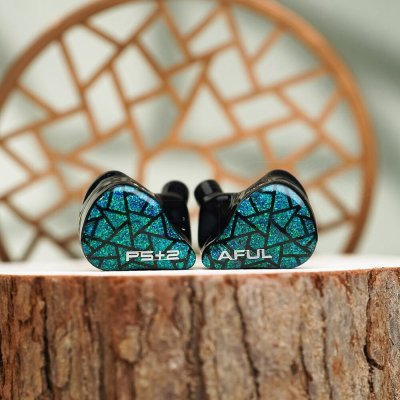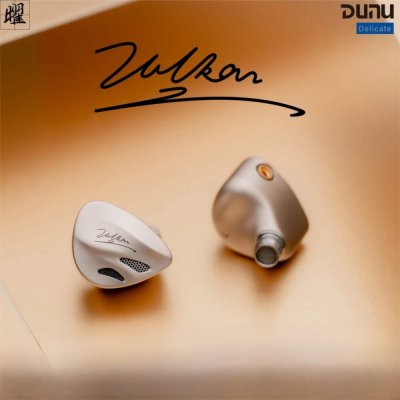Aful Performer 5+2 and Dunu Vulkan 2 use 2DD+4BA+1Planar and 2DD+6BA driver setups respectively. Aful Performer 5+2 costs $229 while Dunu Vulkan 2 costs $360. Dunu Vulkan 2 is $131 more expensive. Aful Performer 5+2 holds a slight 0.4-point edge in reviewer scores (7.7 vs 7.3). Aful Performer 5+2 has significantly better bass with a 1-point edge, Aful Performer 5+2 has significantly better dynamics with a 1-point edge and Aful Performer 5+2 has slightly better imaging with a 0.3-point edge.
Insights
| Metric | Aful Performer 5+2 | Dunu Vulkan 2 |
|---|---|---|
| Bass | 8 | 7 |
| Mids | 8 | 8 |
| Treble | 7.6 | 7.8 |
| Details | 7.6 | 7.7 |
| Soundstage | 7.8 | 7.7 |
| Imaging | 7.9 | 7.6 |
| Dynamics | 7.6 | 6.6 |
| Tonality | 7.8 | 7.6 |
| Technicalities | 7.7 | 7.9 |
Aful Performer 5+2 Aggregated Review Score
Average Reviewer Scores
Average Reviewer Score:
7.7Strongly Favorable
Dunu Vulkan 2 Aggregated Review Score
Average Reviewer Scores
Average Reviewer Score:
7.3Generally Favorable
Reviews Comparison
Aful Performer 5+2 reviewed by Z-Reviews
Youtube Video Summary
Naming drama aside (P5+2? just call it Performer 7), this Aful packs a quirky driver party: 2DD for low end, 4 BA split across mids/treble, plus a tiny micro-planar for the highest sparkle, all marshaled by Aful’s neat miniature crossover. The shells are lightweight, comfy and prettier than they need to be; the cable feels “don’t bother swapping” nice, with 3.5 or 4.4 options. The box is loaded with silicone tips but no foam—a miss, because the right seal changes everything. Price target sits around $250, which sets expectations high but not ridiculous.
Stock silicone yields a surgical, respectful tuning with bass that skews neutral and controlled. Swap to well-sealing foam or hybrids and feed a juicy source (warm Class A or tubes) and the set wakes up—stage snaps into a cohesive scene right in front, imaging gets laser-etched, and that micro-planar adds a pinch-of-salt treble spice without turning harsh. It’s an up-close presentation—sometimes almost claustrophobically detailed—in the best way: think “men with trumpets in the head,” precise placement, and excellent extension up top. Not as rowdy as the Explorers; more like a surgeon in a Hawaiian shirt—technical, but with a wink.
Practical upside: the clarity and positioning make this great for gaming and even viable for mixing/mastering checks; just don’t crank it into pain territory. Bass stays tight and responsive, treble sails high, and coherence holds. Tip and source matter a lot: with foam + warm power, it sings; with plain silicone, it’s merely polite. Final tally: a confident 8.5/10—doing a lot right at its price, dinged half a point for making everyone do math on the name.
Z-Reviews Youtube Channel
Buy Aful Performer 5+2 on HiFiGO
Ad
Price: $213
Buy Aful Performer 5+2 on HiFiGO
Dunu Vulkan 2 reviewed by Z-Reviews
Youtube Video Summary
Opening the serious business packaging reveals the Dunu Vulkan 2 IEMs and a mountain of accessories, including the praised SS tips and the excellent gunmetal gray cable with its satisfying connection mechanism. The build quality screams premium, easily suggesting a price tag of $300-$400 minimum just on looks and feel. The shock comes when discovering these eight-driver hybrids (two dynamics, six BAs) actually cost only $359.99, a fraction of the expected $800-$900 based purely on the sonic experience.
Listening reveals something truly special. The Vulkan 2 delivers an unrestricted sound with a huge soundstage where instruments have ample space and separation, like moving from a cramped elevator to a vast freight elevator. Bass is unapologetically real, not boosted or artificial, while detail retrieval is exceptional across the board. Critically, they achieve this with remarkable sensitivity, sounding fantastic even at whisper-quiet volumes, unlike many complex multi-driver IEMs. They create an incredibly immersive and effortless listening experience, transporting you into the music itself. This performance immediately puts them in direct competition with the previously crowned best-of-year, the Kiwi Ears Astral, despite costing nearly $100 more.
These are declared god tier IEMs. They sound phenomenal regardless of source gear, performing brilliantly on both high-end stacks and budget $200 DAC/amp combos. The Vulkan 2 is deemed absolutely worth $700-$800 in sound quality alone, making its sub-$400 price an incredible value proposition. They are so good they instantly become the pair pulled out to show people what a good IEM sounds like. For anyone saving their pennies for a top-tier in-ear experience, the Dunu Vulkan 2 is presented as an essential, nutty purchase.
Z-Reviews Youtube Channel
Buy Dunu Vulkan 2 on HiFiGO
Ad
Price: $359.99
Buy Dunu Vulkan 2 on HiFiGO
Aful Performer 5+2 reviewed by Jaytiss
Youtube Video Summary
Aful Performer 5+2 lands as a hybrid of the beloved Performer 5 and the punchier Explorer. The unboxing is the familiar P5 affair—same case, same style of tips—nothing flashy, but solid. The shell mirrors the P5 in size with a comfy little stabilizing wing that locks in well. No metal nozzle or front filter here, yet tip retention is secure and hassle-free. The flat 2-pin socket is straightforward, and the stock cable feels thick and supple with a reliable chin slider and handy red/blue channel markers. Overall: understated build, great ergonomics, daily-driver ready.
Sonically, this one aims neutral with a very distinct top end—clean, dynamic, incisive. Think switching from black-and-white to color; cymbals and overtones pop with a slightly crunchy/pristine edge that energizes detail without turning harsh on good recordings. Bass isn’t about sheer quantity; it’s about slam and dynamics—quick on the draw, well-controlled, and satisfying when called upon. Vocals sit a notch forward, microdetail is strong, and the overall presentation is coherent, clear, and technical with convincing stage, resolution, and imaging. Not a treble-shy or bass-bombed tuning—more a refined all-rounder for those who want clarity and bite.
Versus the original P5, the 5+2 fixes the missing “air” and soft edges, trading them for crisper transients and better extension. Compared with Explorer (a value champ), the 5+2 brings superior upper-treble reach, detail, and vocal focus. Against Performer 8 and Cantor, it feels more visceral—the P8 is smoother and more relaxed, while Cantor pulls finer microdetail but with less bass slam. Sets like Dino Quattro or J’s Estrella bring bigger fun or treble theatrics, yet the 5+2’s balance and everyday versatility win more often. Net take: a neutral-leaning, highly technical upgrade that stands tall in its bracket—easy to recommend to anyone chasing clarity, speed, and controlled impact over pure warmth or excess bass.
Jaytiss Youtube Channel
Dunu Vulkan 2 reviewed by Jaytiss
Youtube Video Summary
The Dunu Vulkan 2 boasts exceptional build quality and comfort. Its shell design is praised as extremely nice at any price, fitting securely with a flat two-pin connector, metal nozzle, and helpful anti-tragus catch. The comprehensive accessory package is a major plus, including a pocketable case, 6.3mm and 3.5mm connectors, a cleaning brush, IEM booties, two sets of tips, and a particularly supple cable featuring a screw-lock termination for easy swapping. Everything about the physical presentation feels solid and well-executed.
Sonically, the Vulkan 2 represents an improvement over the original, offering a presentation focused on detail retrieval and a well-done upper mid-range and treble. The overall signature is slightly bright and energetic, leaning towards a treble-focused tonality while still providing sufficient bass to feel rich and supported, though it lacks a thunderous low-end impact. This results in a slightly lean sound that some might find a touch brittle, but the tactful tuning delivers great detail, nice mids, and a presence region comparable to sets like the Moondrop Meteor. Comparisons reveal it has less bass than the DUNU Brain Dance (especially with an impedance adapter) or the Kiwi Ears Astral, but its mid-range and treble presentation are standout strengths.
Despite the slightly lean bass response, the Vulkan 2 emerges as a strong package at its price point. The combination of its superb build, comfort, excellent accessory set, and a detailed, engaging sound signature focused on mids and treble makes it highly compelling. It's recommended for listeners seeking a studio-monitor style presentation rather than a bass-heavy experience. While not a perfect one-and-done for everyone, and a bass adjustment feature like a rumble switch or impedance adapter would be welcome, it stands as a near-endgame option offering great value and quality within the $300-$400 range.
Jaytiss Youtube Channel
Aful Performer 5+2 reviewed by Super* Review
Youtube Video Summary
Aful’s Performer 5+2 upgrades the original hybrid with 2DD + 4BA + 1 micro-planar tweeter and lands around $240–$250. The unboxing is practical: three sets of silicone tips, a pocketable puck case, and a soft, nicely draping cable (available in 4.4 or 3.5), though the braid can look a bit loose and the pre-formed hooks run large. The resin shells shift between blue and green under different light; fit is medium-large, very stable, and comfortable once the right tips are found. Note the narrow nozzle without a retaining lip and partially exposed bores/filters—tip grip is key and a little care prevents ear-gunk ingress.
Tonally this leans mild V-shaped: a clean midrange with a confident bass boost, a touch of lower-treble presence for bite, and well-extended air up top. The result is more incisive and punchy than the original P5, with clearer on/off transients that aid separation and layering. Trade-offs show as a hint of gritty/plasticky treble texture on cymbals and brushes—not harsh, but less natural than ideal—while the bass stays tight and exciting.
Against Aful’s Explorer, this sounds brighter, more spacious, and more technical; Explorer plays warmer/denser with smoother treble but less openness. Versus the pricier Thieaudio Oracle MK3, tuning is broadly similar: Oracle is smoother and deeper with a softer attack, while the Performer 5+2 brings more snap and engagement for less money. As a modern mid-tier hybrid, it absolutely still has a place—energetic, spacious, and well-executed—earning a solid four stars.
Super* Review original ranking
Super* Review Youtube ChannelDunu Vulkan 2 reviewed by Super* Review
Youtube Video Summary
Dunu takes a swing with Vulkan 2’s “Delicate” concept: a hybrid with two DD + six BA tuned for a neutral, midrange-forward presentation. Accessories are generous (modular cable with 3.5/4.4, piles of tips, huge case, famously plush microfiber) and the medium shell fits comfortably, if a bit generic in styling. The snag is the tuning—there’s a pronounced upper-bass/lower-mid dip that strips warmth and weight, making much of the music feel thin; treble is relatively even and not harsh, but the overall result comes off light, bright-by-absence-of-bass, and oddly lifeless.
Stacked against peers, Vulkan 2 feels outgunned. The original Vulkan sounds fuller in the mids even if its treble is drier; Blessing 3 can be lean but isn’t as extreme and actually presents brighter with more treble energy; Softears Volume S brings the tactility and engagement this one lacks while staying broadly neutral. For listeners explicitly seeking very low bass and a forward mid focus, this is a curiosity; for most, the tuning pushes past “lean” into unsatisfying. Verdict: a bold anti-meta idea that misses the mark, roughly a two-star experience in this bracket.
Super* Review original ranking
Super* Review Youtube ChannelAful Performer 5+2 reviewed by Jays Audio
Youtube Video Summary
Performer 7 lands with a neutral-balanced, laid-back tuning and good treble reach. The presentation is clean and generally safe, though there’s a touch of sizzly “planar-ish” timbre up top. Technicals are solid for ~$200—slightly behind sets like Quintet and Super Mix 4, about on par with Nova. Bass from the dual 6 mm DDs is tight, controlled, and free of bleed, but lacks the slam and rumble of competitors using larger drivers; mids are well separated with decent layering.
The weak spot is vocal extension: a push around 1.5 kHz tries to bring them forward, but a dip through 3–6 kHz keeps them from opening up. Tamer upper-mids help avoid fatigue for rock/metal, yet the modest low-end impact leaves drums and basslines feeling uneventful. It’s a mid-volume set that doesn’t scale well—turning it up accentuates the 1.5 kHz emphasis and treble sizzle. Treble isn’t peaky, just a bit glassy at times; for K-pop the smoother mids can work if less extended vocals are acceptable.
As a value play, there are stronger options: Nova, Chopan, and Super Mix 4 offer better bang-for-buck; for a similar clean/neutral target, Tanchjim Origin sounds more natural with better bass texture and vocal reach, and DynaQuattro adds sub-bass and fuller vocals—none with the planar-ish timbre. Even AFUL’s own P5 is cheaper and more fun, while the Explorer undercuts the price and scales impressively. In today’s crowded market, P7 is a competent all-rounder but not distinctive enough to stand out.
Jays Audio Youtube Channel
Dunu Vulkan 2 reviewed by Jays Audio
Youtube Video Summary
Initial skepticism about the Dunu Vulkan 2's significant scoop in the 150-200Hz range quickly faded upon listening. This scoop typically kills rhythmic intensity, slam, and weight, making genres like hip-hop or EDM sound anemic. However, the Vulkan 2 makes it work through a tamer upper midrange compared to Harman targets and a filled-in lower midrange past 200Hz. This creates a smaller contrast (around 7dB difference between peak and mid-bass) than expected, preventing the sound from becoming overly thin or shouty. The result is a surprisingly balanced, neutral, and vocal-centric tonality that excels with artists like SZA, Frank Ocean, or Lana Del Rey on genres such as indie rock, ballads, and acoustic tracks.
This tuning comes with clear trade-offs. The lack of sub-bass is the most significant limitation, making the Vulkan 2 unsuitable for hip-hop, EDM, rap, or movies where rumble and slam are essential. Boosting the sub-bass wasn't feasible without creating an even bigger scoop or ruining the intended neutral, clean vocal focus. Technically, it offers good layering, separation, and a slight bite in transients, with detail and resolution comparable to sets like the Dusk, though not class-leading for its price. It scales well with volume on its preferred genres (around 75-80dB), sounding clearer and more engaging, but falls flat at lower volumes or on energetic pop/EDM where the missing low end hurts balance.
Compared to other neutral/vocal sets like the P50 or Studio 4, the Vulkan 2 is less all-rounded due to its bass deficiency, though it offers slightly better scaling and vocal focus. Bass-centric IEMs like the Odyssey are far superior for low-end engagement. While the vocal presentation is clean and enjoyable within its niche, the $360 retail price is hard to justify. Alternatives like the Volume S (for male vocals) or the Arcanis (for a more immersive, special vocal experience) are better all-rounders that also excel with vocals. The Vulkan 2 becomes a more interesting proposition only if found significantly discounted around $200 as a specialty set for vocal-forward, less bass-dependent genres.
Jays Audio Youtube Channel
Aful Performer 5+2 reviewed by Web Search
The AFUL Performer 5+2 (also listed as “Performer 7”) uses a 2DD+4BA+1 micro planar driver array and AFUL’s LC-network crossover plus a 3D-printed acoustic tube system, aiming for clean band splits without smearing. The shell also integrates a high-damping air-pressure balance system, a design AFUL has used across its line. Official listings put MSRP around $229 and outline the same core tech features.
Tonally it trends neutral with a sub-bass lift: bass has solid depth and texture, mids stay relatively linear, and the presence/treble region adds energy without veering into sharpness on most chains. Multiple reviews characterize it as warm-neutral with bass boost or slightly V-shaped depending on perspective, which matches listening notes about a lively but controlled upper end. Sensitivity and load are portable-friendly (≈109 dB, 15 Ω), so it reaches performance without demanding amplification.
Technicalities are competitive for the class: imaging is tidy with good instrument separation, micro-detail retrieval is above average, and soundstage is moderate (more width than depth). Build and comfort are typical resin-shell fare; some users note occasional lower-treble bite depending on tips and recordings, so treble-sensitive listeners may wish to pair accordingly. Overall value is strong at its price, especially if a clean, bass-supported neutral curve is the priority.
Dunu Vulkan 2 reviewed by Web Search
The Dunu Vulkan 2 employs a dual dynamic driver setup—10mm for sub-bass and 8mm for mid-bass—each in isolated chambers to reduce interference and enhance low-end articulation. Its four-way hybrid crossover (physical + electronic) ensures coherent frequency transitions between the dedicated sub-bass, bass, midrange, and treble drivers, minimizing distortion. The tuning prioritizes textural depth over sheer impact, with sub-bass extension excelling more than mid-bass slam.
Vocals and midrange benefit from custom Knowles BAs, rendering vocals with lush forwardness and emotional nuance, though the 3kHz emphasis occasionally introduces harshness on sibilant tracks. Treble from four custom BAs extends airily without fatigue, offering refined detail retrieval. The soundstage impresses with holographic width and precise layering, handling complex genres like progressive rock adeptly.
Comfort may be divisive: the 6.4mm nozzle and 8g weight per earpiece challenge smaller ears during extended sessions. The stock cable’s Q-Lock Mini system (3.5mm/4.4mm included) and MMCX/2-pin options provide versatile connectivity.
Aful Performer 5+2 (more reviews)
Aful Performer 5+2 reviewed by Audio Amigo
Youtube Video Summary
The AFUL Performer 5+2 (Performer 7 / P7) takes the P5 recipe and adds a second 6 mm dynamic for the lows and a micro-planar for the highs, nudging MSRP to $240. Unboxing mirrors the P5: nine pairs of tips and a decent case, but the accessories feel bare-bones at this price—no foam tips and a non-modular cable, even though the included 8-wire is supple and well-behaved. Build is classic AFUL: 3D-printed resin, blended nozzle (no mesh or lip—watch tip retention), single rear vent, and striking blue-green mosaic shells inspired by Suzhou gardens—cool-wall approved with four compliments to one “meh.” Fit is semi-custom and a touch chunkier than P5; comfortable for most, a conditional pass for small ears. Note a sporadic batch quirk: some units have over-tight 2-pin sockets; exchanges fixed it for affected buyers.
Tuning sits in warm-leaning neutral territory. The dual dynamics deliver punchy, textured bass that rumbles without bloating; guitars and drums carry convincing weight. Mids are the star—rich, full-bodied, vocal-forward without shout, with clean separation and natural tone. Treble from the micro-planar is smooth yet energetic: cymbals and vocal harmonics sparkle, special effects have bite and body, and only treble-sensitives may find hot mixes a bit lively. Technicalities impress for the money—detail retrieval and nuance feel a class up—while stage and imaging are solid rather than showy.
Against peers: the Tangzu x HBB budget pick mirrors the overall tonality but P7 offers higher resolution and more treble finesse; the planar “Heyday” alternative is brighter/faster with leaner bass; versus Performer 5, P7 brings tighter low-end, smoother treble, and better extremes detail; the Fresh-collab competitor pushes vocals further forward with bigger stage but leaner lower mids. Verdict: a versatile all-rounder that suits broad libraries and even content creation thanks to its balanced tonality and detail. Not for bassheads, trebleheads, or strict Harman-lean seekers, and the accessory pack/cable quirk holds it back from a slam-dunk. For roughly $240, though, it’s a brilliant, resolving upgrade in the AFUL line.
Audio Amigo Youtube Channel
Aful Performer 5+2 reviewed by Kois Archive
Kois Archive Youtube Channel
Aful Performer 5+2 reviewed by Audionotions
Aful Performer 5+2 reviewed by Gizaudio Axel
Gizaudio Axel original ranking
Gizaudio Axel Youtube ChannelAful Performer 5+2 reviewed by Tim Tuned
Dunu Vulkan 2 (more reviews)
Dunu Vulkan 2 reviewed by Paul Wasabii
Youtube Video Summary
Vulkan 2 is an 8-driver hybrid (2DD+6BA) tuned for a mids-forward presentation, echoing the EJ07 approach but with DUNU's brighter, more present upper range. A modest 5 dB bass shelf and a mid-bass dip keep the low end clean and quick while pushing attention to the heart of the mix. Vocals come through emotive, textured and open; female voices gain extra energy from the upper-mids, while male vocals can pick up a touch of BA edge. This is not aimed at V-shaped preferences—engagement is built around the mids rather than big bass or treble fireworks.
Bass focuses on quality and control—tight hits, fast decay, no lingering bloom—building clear layers into the midrange. The treble is polished and natural with a gentle upper-treble roll-off: no fake air, no grain, and enough presence to surface detail without harshness. Resolution presents as resolving in a natural way and is source-revealing; added warmth or EQ tends to detract from the coherence of the stock tuning.
Stage is neat and three-dimensional with clean separation, good depth and stable imaging, though a bit more intimate than EJ07. Overall it reads as a refined, slightly brighter spin on that recipe: standout mids, disciplined and speedy bass, and a tasteful top end that favors realism over spectacle—engaging for mid-centric listeners, but genre-dependent if heavy mid-bass is required.
Paul Wasabii Youtube Channel
Dunu Vulkan 2 reviewed by Head-Fi.org
Aful Performer 5+2 Details
Driver Configuration: 2DD+4BA+1Planar
Tuning Type: Neutral with Bass Boost
Brand: AFUL Top AFUL IEMs
Price (Msrp): $229
Support our free service! Buying through our affiliate links costs you nothing extra:
Dunu Vulkan 2 Details
Driver Configuration: 2DD+6BA
Tuning Type: Neutral, Vocal-focused
Brand: DUNU Top DUNU IEMs
Price (Msrp): $359.99
Support our free service! Buying through our affiliate links costs you nothing extra:
Aful Performer 5+2 User Review Score
Average User Scores
Average User Score: n/a
Based on 0 user reviews
No user reviews yet. Be the first one who writes a review!
Dunu Vulkan 2 User Review Score
Average User Scores
Average User Score: n/a
Based on 0 user reviews
No user reviews yet. Be the first one who writes a review!
Aful Performer 5+2 Gaming Score

Gaming Score & Grade
- The gaming score is prioritizing technical capabilities of the IEM (Separation, Layering, Soundstage) and good value.
Gaming Score
7.7Gaming Grade
ADunu Vulkan 2 Gaming Score

Gaming Score & Grade
- The gaming score is prioritizing technical capabilities of the IEM (Separation, Layering, Soundstage) and good value.
Gaming Score
7.5Gaming Grade
AAful Performer 5+2 Scorings
Average Technical & Tuning Grades
Average Tunign Grade
A- Tuning feels well executed, keeping a natural flow across the spectrum. Switching genres feels seamless.
Average Technical Grade
A- Overall technical control is strong, presenting instruments with clarity and sensible staging. Textures are portrayed with satisfying clarity.
Dunu Vulkan 2 Scorings
Average Technical & Tuning Grades
Average Tunign Grade
A- You get a polished tonal profile that stays natural from bass through treble. Subtle tuning choices keep things engaging.
Average Technical Grade
A- It delivers a confident technical showing with defined layers and satisfying clarity. You can follow backing vocals with relative ease.
Aful Performer 5+2 User Reviews
"This is an example review"
Pros
- Example pro 1
- Example pro 2
Cons
- Example con 1
- Example con 2
Share your experience and build your personal ranking list.
You need to be signed in to write your own reviewDunu Vulkan 2 User Reviews
"This is an example review"
Pros
- Example pro 1
- Example pro 2
Cons
- Example con 1
- Example con 2
Share your experience and build your personal ranking list.
You need to be signed in to write your own reviewFind your next IEM:
IEM Finder Quiz
newIEM Comparison Tool
newVS



























